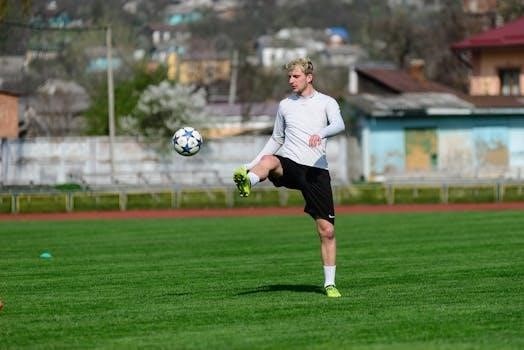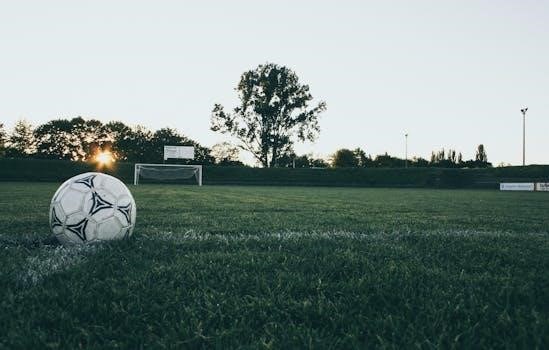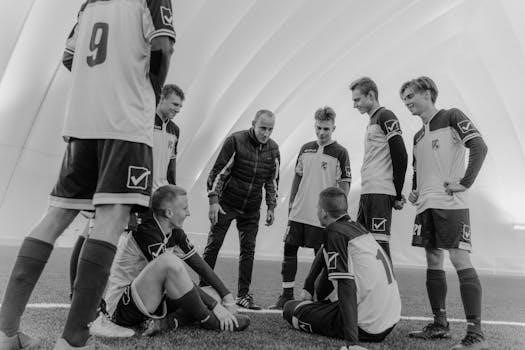Off-season soccer training is crucial for players looking to enhance their skills and fitness. It’s a period dedicated to development, focusing on areas that might be neglected during the regular season. The off-season provides an opportunity to focus on personal improvement, physical conditioning, and mental preparation for the next season.
Importance of Off-Season Training
Off-season training is paramount for soccer players aiming to elevate their game. This period provides a unique opportunity to address individual weaknesses, build a robust fitness base, and refine technical skills without the pressures of competition. Unlike in-season training, where the focus is often on maintaining form, the off-season allows for concentrated effort on areas needing improvement. This includes strength training, enhancing speed and agility, and working on specific soccer skills. Players who utilize the off-season effectively will gain a significant advantage. It helps in injury prevention, improves overall performance, and boosts mental resilience. Neglecting off-season training can lead to a decline in fitness and skill, making it harder to compete when the season starts. A well-structured off-season program can dramatically enhance a player’s ability to perform at their peak level throughout the year. This focus ensures that players enter the new season in better shape than when they finished the last, leading to improved performance and more consistent results.

Phases of a Soccer Training Year
A soccer training year is typically divided into distinct phases⁚ early pre-season, late pre-season, in-season, and off-season. Each phase has specific goals and focuses on different aspects of player development and conditioning.
Early Pre-Season Training
Early pre-season training marks the beginning of preparation for the upcoming soccer season. This phase typically focuses on re-establishing a fitness base after the off-season break. It’s a time for gradual increases in training volume and intensity. Activities often include general conditioning exercises like running, bodyweight workouts, and light strength training to prepare the body for more intense work. The emphasis is on building a solid foundation of aerobic fitness and muscular endurance, gradually increasing the player’s capacity to handle higher workloads. Speed and agility drills are also incorporated to reintroduce these vital soccer-specific skills. This phase is crucial for preventing injuries and ensuring players are physically ready to progress into later phases of training. It’s also a time to re-familiarize with basic soccer movements and touches on the ball, preparing for more specific technical training.
Late Pre-Season Training
Late pre-season training builds upon the foundation established in the early pre-season phase. This period focuses on refining soccer-specific fitness and skills, transitioning from general conditioning to more intense workouts. Training sessions incorporate more interval running and high-intensity movements to replicate game situations. Strength training becomes more focused, with exercises designed to improve power and explosiveness. Technical drills are increased, with an emphasis on ball control, passing, and shooting under pressure. Players are also introduced to tactical concepts and team strategies, with small-sided games used to improve decision-making and match intelligence. This phase is crucial for fine-tuning all aspects of a player’s game, ensuring they are physically, technically, and tactically prepared for the demands of the upcoming season. The focus shifts from building a base to preparing for the intensity of match play.
In-Season Training
In-season training is tailored to maintain fitness levels and optimize performance during the competitive period. The primary objective during this phase is to balance training with recovery, preventing overtraining and injury. Training sessions are structured around game schedules, with a focus on tactical preparation and team cohesion. Physical conditioning is reduced, with a greater emphasis on maintaining strength and speed through targeted exercises. Technical drills focus on game-specific skills and decision-making under pressure. Recovery is crucial, with emphasis on proper nutrition, hydration, and rest. In-season training also focuses on addressing individual player needs and addressing weaknesses identified during matches. The goal is to ensure peak performance throughout the season while minimizing the risk of burnout and injury. It is crucial to maintain a high level of intensity while balancing workload to ensure players stay fresh and sharp for each match.
Off-Season Training
Off-season training is a critical phase for soccer players to focus on individual development and prepare for the upcoming season. This period allows players to address weaknesses, improve fitness, and build a strong foundation. The off-season program should include a mix of physical conditioning, skill development, and mental preparation. Strength training, speed and agility drills, and interval running are essential for physical development. Skill work should focus on refining technique, improving ball control, and enhancing decision-making. Mental toughness training helps players develop resilience and focus. Nutritional guidance is also important to support training and recovery. Off-season training provides an opportunity to make significant gains without the pressures of competition. It’s a time to work on personal goals, develop overall athleticism and ensure players are well-prepared for the rigors of the next season. This program should be comprehensive and encompass all aspects of player development.

Key Components of Off-Season Training
Off-season soccer training should include physical conditioning, skill development, mental toughness, and nutritional guidance. These components ensure a holistic approach, maximizing player improvement and readiness for the upcoming season.
Physical Conditioning
Physical conditioning during the soccer off-season is paramount for maintaining and enhancing performance. It typically involves a combination of aerobic and anaerobic training. Soccer requires frequent high-intensity movements, so interval running is crucial. This involves short bursts of intense activity followed by periods of rest or low-intensity activity. Strength training is equally important, and it is recommended to focus on building maximum strength during the off-season, as it can take up to 12 weeks to develop. This part of the program may include speed and agility drills, like box drills, shuffling, and sprints. Bodyweight exercises and medicine ball exercises can also be incorporated to build strength and power. Moreover, a proper warm-up and cool-down routine are essential to prevent injuries. The off-season period also presents a good opportunity to focus on mobility and flexibility, which will aid in injury prevention and improve overall performance. Remember, the goal is to enter the pre-season in optimal shape and ready to excel.
Skill Development
Skill development during the off-season provides a crucial opportunity for players to refine their technical abilities. This phase should not only focus on maintaining existing skills but also aim to improve weaknesses. Consistent ball work is essential; this could include drills for ball control, passing accuracy, and dribbling techniques. Off-season training should incorporate time with a ball, even during fitness drills. Players should aim to develop their weaker foot and improve their decision-making skills by practicing in various game-like scenarios. It is important to simulate game situations to improve match intelligence. Incorporating specific drills that mimic game scenarios can help players apply skills under pressure. Furthermore, working on individual techniques can give players an edge during the season. This period is perfect for breaking down specific skills and working on them individually. Finally, focusing on technique and skill will improve the overall performance of a player.
Mental Toughness
Mental toughness is a critical component of off-season training, often overlooked but essential for success. This phase provides an ideal time to develop resilience, focus, and a positive mindset. Players should work on goal setting and visualization techniques, creating a roadmap for their improvement. Strategies for managing pressure and setbacks should be implemented. This could involve mindfulness exercises to improve concentration and emotional control. Off-season is a time to build confidence by working on personal strengths and overcoming weaknesses. Players can use this time to work on their commitment and consistency. It is important to develop a strong mental game in order to be a successful player. Consistent training during the off-season can help in developing a more positive mental attitude. The mental side of the game can often be more important than the physical side. Building a strong mental attitude is essential for success.

Nutritional Guidance
Nutritional guidance during the off-season is pivotal for optimal recovery and performance. Players should focus on a balanced diet that supports their training regimen. This includes consuming adequate protein for muscle repair and carbohydrates for energy. Hydration is also key, with water intake being a priority. Off-season is the perfect time to establish healthy eating habits that can be maintained during the competitive season. Players should avoid processed foods and sugary drinks and opt for whole foods. This is also a good time to experiment with different healthy meals to find what works best. Understanding the proper timing of meals can significantly impact performance and recovery. Individual needs may vary, thus personalized nutritional plans can be beneficial. This involves consulting with a nutritionist or a sports dietitian. Proper nutrition is essential to improve physical conditioning and performance on the field.

Sample Off-Season Training Programs
Off-season programs vary in length and intensity. Here, we explore two examples⁚ a six-week program for a quick boost and a twelve-week program for more substantial improvements. These programs include fitness, skills, and mental training.
6-Week Program Example
This six-week program is designed to help soccer players maintain fitness and enhance skills during the off-season. It focuses on a balance of physical conditioning, technical work, and mental preparation. Week 1 includes two-mile runs, stretching, and some ball touches. Speed and agility are addressed through box drills, shuffling, and sprints. Circuit training with bodyweight exercises and medicine ball work is incorporated to build strength and endurance. This phase aims to build a solid foundation for more intense training. The program also includes interval running to mimic game-like situations with short, high-intensity movements. The following weeks will continue to build on these foundations, increasing the intensity and duration of workouts. This six-week program will get you ready for your preseason, season or first pro trial. It is also designed to help those who want to know what type of fitness you will need if you are to play professionally. This period is crucial for players aiming to stay in shape and improve. It’s designed to prepare you for the next season.
12-Week Program Example
A 12-week off-season program provides a more comprehensive approach to soccer training, allowing for a gradual increase in intensity and volume. This program is structured into 3-week cycles, with each cycle focusing on specific aspects of training. It includes high-intensity workouts and lower intensity sessions. The aim is to create a balanced approach that allows for sufficient recovery while achieving peak performance levels. This comprehensive program incorporates both aerobic and anaerobic training, often using a soccer ball to enhance sport-specific skills. The program also emphasizes strength and power development, which can be especially important during the off-season, this phase allows for maximum strength gain if you prioritize it. This program includes speed and agility drills to improve quickness and change of direction. The 12-week program ensures that players are in top condition when the new season begins. It allows for more in-depth skill development, injury prevention, and a focus on mental toughness. This prolonged period of training ensures that players are well-prepared for the demands of the upcoming season.


